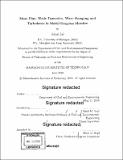Mass flux, blade dynamics, wave damping and turbulence in model seagrass meadow
Author(s)
Lei, Jiarui,Ph.D.Massachusetts Institute of Technology.
Download1128185283-MIT.pdf (30.55Mb)
Other Contributors
Massachusetts Institute of Technology. Department of Civil and Environmental Engineering.
Advisor
Heidi M. Nepf.
Terms of use
Metadata
Show full item recordAbstract
Aquatic vegetation provides ecosystem services of great value. Seagrass and fresh-water macrophytes can improve water quality by filtering nutrients and reducing re-suspension of sediment. They can also protect shorelines by damping waves. This thesis explores the interaction between flexible vegetation (e.g. seagrass) and water flow. Specifically, I develop physically based models to predict the mass flux to individual seagrass blades, the dynamic behaviors of seagrass blade, the wave decay associated with a submerged meadow and the turbulence within a seagrass meadow as a function of plant morphology, flexibility, and shoot density. Flexible plants/blades reconfigure in response to flow velocity, which reduces drag relative to a rigid plant of the same morphology. The impact of reconfiguration on drag can be characterized using an effective length, l[subscript e], which represents the length of a rigid blade that generates the same drag as the flexible blade of length l. The effective blade length depends on the Cauchy number, Ca, which defines the ratio of hydrodynamic drag to restoring force due to blade stiffness. To validate our proposed models, a combination of laboratory experiments and numerical simulation was conducted. Our models also produced good predictions for different laboratory and field studies within 30 %. With these models, engineers and practitioners will be able to assess different scenarios of vegetation restoration for their potential to protect shorelines and to reduce erosion events that drive poor water quality.
Description
Thesis: Ph. D., Massachusetts Institute of Technology, Department of Civil and Environmental Engineering, 2019 Cataloged from PDF version of thesis. Includes bibliographical references (pages 159-168).
Date issued
2019Department
Massachusetts Institute of Technology. Department of Civil and Environmental EngineeringPublisher
Massachusetts Institute of Technology
Keywords
Civil and Environmental Engineering.